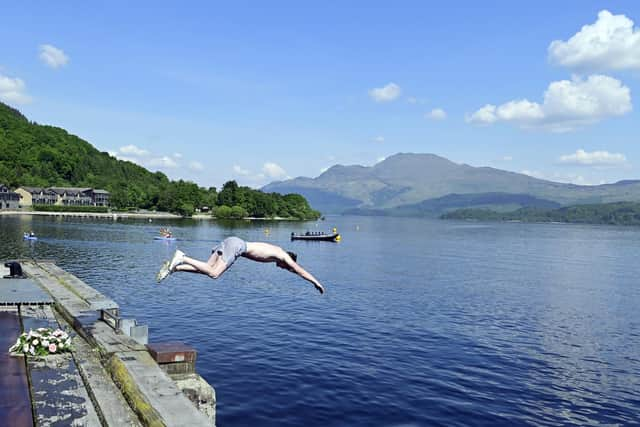Why Flamingo Land plans for Loch Lomond have sparked 95,000 objections
It is a leisure development that has ruffled feathers in the heart of one of Scotland’s most idyllic beauty spots.
Flamingo Land, a theme park operator in Yorkshire, wants to build a new resort at the southern tip of Loch Lomond, arguing that it would create hundreds of jobs and raise around £3 million for the local economy in one of the nation’s leading tourism destinations.
Advertisement
Hide AdAdvertisement
Hide AdBut among those who believe the natural landscape of the beloved banks should be preserved at all costs, the anger and emotion is palpable, with more than 95,000 people putting their name to an online petition opposing the plans.
So what is the status of the Lomond Banks development, what is the view of authorities, and who, ultimately, will decide its fate?
The issue has been a major talking point among communities around Loch Lomond for the best part of eight years. Flamingo Land first drew up proposals for a tourist development, including a hotel, craft brewery and leisure centre, back in 2016.
Those plans were met by a wave of opposition, with more than 55,000 people signing a petition opposing them. In September 2019, the firm decided to withdraw its proposals, only to return the following year with a revised £40m project which incorporates a water park, hotel, monorail, and restaurants.
It will be for the 10 strong planning and access committee of the Loch Lomond and Trossachs National Park Authority (LLTNPA) - and, perhaps, its 17-strong main board - to make a determination once the consultation process has come to. Even after that point, there is a chance that Scottish ministers could decide to call in the application to ultimately make the decision themselves, given its scale and controversy.


As a statutory planning authority, the LLTNPA has not offered any views so far regarding the development, and its assessment will be largely driven by the development’s compatibility - or otherwise - with local development plans and planning guidance.
Others, however, have been vocal, with the Scottish Greens describing it as “by far the most opposed planning proposal in Scottish history.” Patrick Harvie MSP, the party’s co-leader, said this week: “If these proposals are given the green light they would destroy a beautiful site on the banks and cause irreversible damage to the local environment. No wonder so many people are objecting to them.”
For their part, the developers say their latest submission contains a recently updated summer transport assessment highlighting the “minimal impact” on existing roads, alongside supporting potential upgrades to the A82’s Stoneymollan roundabout. They also point to what is known as the “Lomond promise”, a voluntary undertaking which legally binds the developer into a number of obligations, including no zero-hour contracts, real living wages, and job and training opportunities for local people.
Advertisement
Hide AdAdvertisement
Hide AdJim Paterson, the project’s development director, has said that Lomond Banks will not only “revitalise the gateway to Loch Lomond,” but offer an added boost to existing complementing businesses that already operate here and “provide numerous opportunities for those keen to work with a progressive and forward-thinking employer.”
In deciding whether the project should be rubber stamped, the LLTNPA will take into account not just the 95,000 plus signatories to the petition of opposition set up by the Scottish Greens – which argues that the development’s scale is incompatible with the LLTNPA’s local plan, and runs contrary to its sustainable and active travel policy - but the views expressed by statutory consultees, several of which have already been lodged with the LLTNPA via its planning portal.
Balloch and Haldane Community Council is among those consultees opposed to the plans, citing concerns about the impact on public services, local greenspace, flooding risks, and the amount of land that would be developed for tourism purposes in a village and community that, in their words, “still lacks basic facilities.”. Its other grounds of objection include the increase of traffic on the A82.
Indeed, traffic is an issue raised time and again by several consultees. Jackie Baillie, the local Scottish Labour MSP, has warned there is insufficient capacity on the roads to cope without mitigation. West Dunbartonshire Council’s roads department, meanwhile, has advised that the development’s traffic impact would be “above the impact threshold” as set out in the transport assessment guidance, and would require junction modelling work to be carried out on the A811.
The council’s flood officer said that given the “early stage” of the process, it cannot give a definitive response with regards to flooding until completion of the detailed design stage. More generally, however, the local authority, which opposed Flamingo Land’s original 2017 plans, has said that the new scheme would be “positive” in terms of increasing local job opportunities and tourist numbers, which it argues could benefit businesses and traders in the area. That view, however, should not be seen as representative of every elected representative in the region.
Indeed, Jonathan McColl, the local council for the Lomond ward, has written to the LLTNPA, arguing that the development, if approved, will have precisely the opposite effect. “The application is not in keeping with the park authority’s primary and overriding policy objective of conserving and enhancing the natural and cultural heritage of the area.” he reasoned.
“Given the type of development being proposed, it is more likely that the site will be in direct competition with local accommodation, hospitality and leisure facilities; the risk to local jobs and businesses is unacceptable.”
Elsewhere, the Scottish Environmental Protection Agency initially submitted a holding objection, having warned that it is uncertain if the planned flood mitigation works, which involve elevating proposed lodges above the flood level and interconnecting them with raised footpaths, is technically feasible from a flood risk perspective. Its latest position, according to correspondence, is “one of objection subject to modification.”
Comments
Want to join the conversation? Please or to comment on this article.